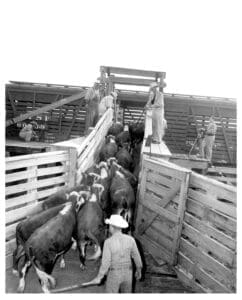By Chris McClure Contributing Editor
What do you do when the things you have always done no longer seem to work? Do you try something new, or do you keep on with the same tried-and-true approaches that paid dividends in the past?
As I look at the cattle feeding industry, I see a lot of aging, or perhaps I should say, worn out infrastructure. Occasionally there are new pens added, feed mills replaced, shipping facilities redesigned and replaced, hospitals rebuilt and, very rarely, new yards built from scratch. The reality is that there isn’t a lot of change to the way feedyards have been designed since they first started becoming common across the High Plains in the 1960s and ‘70s.
There are several instances where older yards, which were once in the country, are now surrounded by housing developments. Inevitably, pressure from those residents results in those facilities closing, making way for more houses. Casa Grande, Ariz., birthplace of a certain magazine, comes to mind.
As facilities become needful of replacement rather than maintenance, is it time to give serious thought to a complete redesign of how we approach cattle feeding? I can almost hear the marbles rattling as those with a lifetime of cattle feeding experience shake their heads, wondering what this crazy writer has in mind and how he could possibly have any idea what he is talking about. The bare truth is that I don’t, but I do know that continuing to do the same thing repetitively and expecting different results seems a fruitless effort.
Many feedyards have focused on efficiency. There is obvious merit in that approach because it tends to minimize waste. It is a factory approach that allows cookie-cutter precision along a specific line of production. It takes advantage of the law of averages – average finish time for a specific size and type of cattle. The problem with that approach is that it is built on a bell-shaped curve, which has “tails.” Those “tails” are cattle that become either over finished or under finished.
Some yards use sorting methods to attempt minimizing the size of those “tails.” Weight is the most often used metric for such sorts, but other things such as specific DNA markers are also candidates for determining the likelihood of an animal finishing within an expected “window” that would maximize profitability for the group.
More sophisticated systems have also been applied utilizing frame scores, phenotypic data, weights, hip heights, etc., to project “out dates.” Those systems rarely succeed due to the human elements of managing the cattle to take advantage of the projections. We have yet to truly manage animals based on their individual genetic capabilities. Until we can do so, complexity will most likely either lead to failure or, at best, fail to live up to expectations. The cost outweighs the benefits.
The computer industry utilizes the concept of infinite customization. The parts and pieces of the puzzle are standardized, but the way in which they are assembled is based on the requirements of the customer. To date, cattle feeders have left this aspect of beef production to the packers. Is there a way to move that function to the feedyard? Is there a way to sort cattle to target specific outcomes?
We have done so to some extent by focusing on the types of cattle fed. Some yards are zeroed in on quality grades while others are focused on commodity cattle. Some yards have uniform pen sizes while others have an endless variety of pen sizes and shapes. Some yards send all their cattle to a single packer while others seek competitive bids.
Doesn’t it make sense to remain flexible so that you aren’t trapped in a specific channel or method of doing things? With a Choice/Select spread that seems to have permanently become wider than historically expected, doesn’t it make sense to try getting more cattle to their optimum finish weight and condition rather than overfeeding high-priced feed to some and failing to get enough finish or weight on others? True efficiency can only be obtained when we shift our thinking to the individual animal rather than the convenience of how we manage.
Okay, that sounded a little preachy. I’m not qualified to be preachy, but let me attempt to clarify: More money flows to the bottom line if more is going into the top – the sales side of the income statement. Expenses must be controlled, but the greatest return is by maximizing the value received for the money spent. Until we can completely control the genetics of the animals we are feeding, we can’t control the outcome unless we customize our approach to meet the needs of the animal. Until we feed the animals based on their needs rather than our convenience, we will never maximize the outcomes.






